Overview
A New Career Development Tool for Lawyers
The Oxford Program is proud to introduce its Oxford Legal Career Aptitudes Program. It utilizes the Highlands Ability Battery Lawyer’s Report which is designed to reflect the uniqueness of people who study and practice law. Whether you have just entered the profession or have been practicing for years, this useful tool can help by pointing you towards areas of law practice you are likely to excel in and enjoy. It will also tell you how to draw on your natural abilities to manage your practice, supervise associates and staff, and deliver effective service to your clients.
The Highlands Ability Battery measures your innate abilities; the Lawyer’s Report describes their relevance to you personally. The terms “ability” and “natural abilities” are used to describe the degrees of your natural performance in a variety of work functions, all of which mature in most people at or about age fifteen. Abilities are distinguished from skills, which are defined to mean performance based on ability but enhanced through learning, practice and experience. Your present level of performance – i.e., what you are able to do at this moment – is determined by calling upon the combination of your natural abilities and your skills.
The Battery measures your abilities objectively by requiring you to perform specific tasks called worksamples, not by asking you to describe yourself or by asking you to answer questions about yourself. This approach enables you to know what kinds of tasks come easily to you, and also which tasks are more difficult for you. The speed with which you perform a particular task is one important measure of how easy that task is for you. When a task needs more effort – when the answers do not come quickly – it may be because the ability required is not a strong ability for you. In most worksamples, your speed as well as your success at performing a particular task is measured.
For each worksample, your results are given as percentiles. This means that your results are compared to the results of all persons who have taken the same worksample over the last seven years. Your results provide an objective way to compare how you did on the worksample with how other people have done. If you scored high in one ability as compared to other people, you can conclude that this is a strong ability for you. If you scored low, this will tell you something important about yourself. Keep in mind – it’s not important to have a high score on every worksample; but, it is important to know and understand what each of your scores means for you in the practice of law.
Understanding your scores will help you to identify:
- The practice area and work environment likely to feel most comfortable to you.
- How you learn new information most easily.
- How you solve problems and make decisions.
- How you communicate with others.
Every Lawyer Has a Pattern
Every attorney has a distinct pattern of abilities. There are no “good” patterns or “bad” patterns. Every pattern means that some things will be easy to do or learn others more difficult. Individual reports offer suggestions on specific actions you can take to capitalize on your unique pattern of results and increase your effectiveness as a lawyer throughout your career.
The Ability Battery Lawyer’s Report offers analysis in the following areas:
The Generalist/Specialist Scale describes how people process and take in information, how they communicate with others, and how they respond to and manage such group dynamics as consensus building and loyalty. At one end, Generalists enjoy a variety of interests and projects; at the other end, Specialists like to focus on their own projects and develop their own areas of knowledge. Generalists are drawn to matters which enable them to become involved in every part of a matter and to work through other people; Specialists prefer to contribute to a specific element of the process. Unlike the rest of the population, lawyers often qualify as Specialists – they need to express themselves as individual contributors or experts. This does not mean they are unable to perform as contributors to a team – only that their contributions may be different.
The Extrovert/Introvert Scale shows how you react to the people around you and with whom you work – which contacts energize you and which are draining. It tells how you prefer to think through or process new information. Extroverts enjoy working with others; introverts tend to look inward and like structure in their relationships. Of course, some people fall in the middle of the Introvert‐Extrovert scale and find they need a workplace that provides a combination of activities.
The Time Frame Scale illustrates how different lawyers think about and utilize time in planning and managing their responsibilities. How far into the future is the attorney likely to look? What is his or her tolerance for the length of time between a decision and a result? What steps will he or she take if a goal is not reached within the time allotted? While everyone tends towards one of three natural time orientations (immediate, intermediate and long range), successful lawyers know that they have to build skills and methods which enable them to operate in all three. Nothing in a typical lawyer’s profile would suggest an inability to adapt to and perform well in a different style. The process of adapting to a different style becomes a skill that successful lawyers learn over time and use often.
Driving Abilities include Classification; Concept Organization; Idea Productivity; Spatial Relations Theory; and Spatial Relations Visualization. They are very powerful and pressing, and they influence almost every part of a lawyer’s work life. The Driving Abilities are:
Classification (CL), or diagnostic thinking, measures the ability to see a relationship among seemingly unrelated facts or objects – by seeing the relationship easily and quickly, a lawyer is able to “diagnose” a problem in the same way a doctor does. A lawyer with a high classification ranking can see the problems in a new matter almost immediately.
Concept Organization (CO), or analytical thinking, is the ability to solve problems logically and linearly and is used when lawyers write, devise strategy, predict what will happen in the future, or analyze what went wrong when some tactic has failed. Experience has shown that when arranged in patterns or combinations, CL and CO together yield nine distinct and identifiable problem‐solving patterns. Because your job as a lawyer is to confront and solve problems at every turn, it becomes essential to know the pattern, which is most natural to you.
Idea Productivity measures the number of new ideas you are able to generate within a given time in response to a set of new and imaginary facts. The quantity of your ideas, not their quality is measured. We assess your capacity for idea generation, your ability to stay focused on one task or idea, and your natural preference for the way in which to respond to new ideas. Some lawyers prefer to articulate and focus on one idea at a time (“focusing”); others prefer brain‐storming sessions in which people are urged to articulate and consider many ideas at once (“brainstorming”). Spatial Relations Theory (SRT) measures the ability to “see” (conceive) and manipulate three dimensions in space. It is a helpful tool in solving theoretical or abstract problems. Lawyers high in SRT are most satisfied when they can say, “I conceived this,” or “I designed this.” Lawyers with low SRT are most satisfied when they can say, “I did this.”
Spatial Relations Visualization (SRV) demonstrates the ability to visualize and manipulate tangible objects floating in space. People who score high in this ability need to see and feel the results of their work in tangible form. They are most satisfied when they can say, “I built that”, or “I made this.” They will be drawn to practice settings – real estate (transactional), environmental law, patent law, IP, project or asset finance – all of which enable them to point to something tangible as a result of their work. Lawyers who are low in SRV are most satisfied when they can say, “I solved this.” They are exhibiting the tendencies required for work in the service and financial industries.
Learning Channels measure how lawyers take in and process new information best – some read to learn; some listen to learn; some learn through movement; some rely on pictures, charts and graphs; and some depend on their ability to remember and recall numbers. The greater the number of strong learning channels, the greater the need to find new things to learn. Lawyers who have three or more strong learning channels may find that they are ready to move on if the job no longer offers new opportunities to learn. The drive to learn will force lawyers to seek new challenges. If happy with colleagues and the work environment, but unable to find new challenges at work, they may be able to cure their ennui by taking courses in a local college, joining a discussion group, becoming political activists, or volunteering for work with a non‐profit charitable organization. Also, successful lawyers understand that different people learn in different ways. They teach themselves to transmit their instructions and messages to their associates and clients by the most productive means – measured not by their own learning tools, but by the tools of the people they’re communicating with.
Your individualized Ability Battery Lawyer’s Report offers a detailed explanation of your abilities, what they mean for you, and how they relate to your performance as a lawyer. As a vital part of the Highlands experience, a specially trained and certified Highlands Affiliate provides a feedback conference to interpret your results and teach you how to make maximum use of your natural abilities as you face career challenges today and in the future.
Who is it for?
- High school students who want to understand if they have the right profile to succeed in the legal profession.
- Law school students who want to achieve the highest levels of success and satisfaction in the legal professions by aligning their strongest talents with their career.
- Practicing lawyers who want to diagnose any natural ability/personality conflicts to achieve more satisfaction within or outside the legal professions.

FREE Report Download
The 5 Myths Regarding the Practice of Law ![]()
The best way to avoid making the wrong career decision is to educate yourself regarding the realities of law practice.
How It Works
 STEP 1: TESTING
STEP 1: TESTING
PART 1: Personal Style Assessment. You will start by completing a specially designed intake questionnaire about your interests and preferences related to careers in general.
PART 2: The Highlands Ability Battery. The Highlands Ability Battery™ is the gold standard in testing career-related abilities.
The Battery is a series of 19 timed work-samples that measure and define your natural abilities. This is not like any other test you’ve ever taken. There are no grades or no good or bad results. Each work-sample measures a particular aptitude and you’ll be amazed how much they reveal about you.
Opposed to interest or personality testing, you cannot influence the Highlands Ability Battery to produce false results.
How accurate is it? This is not like the aptitude testing from years ago, or the tests available in certain books out there. The information and suggestions that it makes are HIGHLY ACCURATE. The testing is psychometrically valid and reliable. The minimum reliability standard for the 19 tests that make up The
Highlands Ability Battery is r = . 80.
After you complete the Battery, you will receive a 33-page report describing your results in detail.

PART 3: Oxford CareerFitNow Analysis. The Oxford CareerFITNow Analysis will analyze your interest patterns, providing a window into your personality and “role in life”.
In addition to your abilities discovered with the Highlands Ability Battery, this assessment allows us to understand what fields satisfy your interests and will provide you the motivation to be happy and successful.
You receive your CareerFITNow report which compares your natural inclinations to the results of people who are successfully employed in professions and provide recommendations on specialties matching your talents and interests.
 STEP 2: MATCHING PROCESS
STEP 2: MATCHING PROCESS
After you have completed the testing, your results will be used to create a report which explains what they mean, along with profile matches.

 STEP 3: FEEDBACK SESSIONS
STEP 3: FEEDBACK SESSIONS
After the testing is complete, you will have a follow-up feedback and interpretation session with the Oxford Program founder, Steve Bohler, to discuss the results.
Discover where YOUR excellence, success, and happiness will be!
The Highlands Ability BatteryTM (THAB) is the gold standard among tools assessing human abilities or aptitudes.
The Battery consists of 19 different worksamples. Each worksample is timed to measure the speed with which the individual is able to do a particular series of similar tasks. The individual’s score on each worksample establishes whether a particular task is more or less easy for that individual. Shown together on a personal profile and bar chart, the scores achieved by each individual reveal patterns or “clusters” of abilities which require analysis by a skilled interpreter. Once these patterns or “clusters” are understood, the individual is helped to guide his life and work into more productive and satisfying channels.
More than any other test, it helps you understand the type(s) of work you should pursue and the types you should definitely not pursue.
In October, 2002, 32 students at Colorado State University were asked to compare a number of assessments which they had completed as part of their course.
The group was asked to rate 4 different well-known assessments in terms of effectiveness in measuring their abilities and talents, as well as in guiding them in future career decisions. The assessments were the Highlands Ability Battery, the Myers-Briggs Type Indicator, the Strong Interest and Skills Confidence Inventory, and True Colors.
Percentage of Students that ranked it #1 in measuring abilities and talents

Percentage of Students that ranked it #1 in effectiveness in guiding them in career decisions
How accurate is it?
This is not like the aptitude testing from years ago, or the tests available in certain books out there. The information and suggestions that it makes are HIGHLY ACCURATE. Many medical, technology, business, and science students use this aptitude testing to choose an area of specialization. Businesses use it to choose the top candidates for important positions. Entrepreneurs use it to determine the type of business they’re most likely to be successful in. The testing is psychometrically valid and reliable. The minimum reliability standard for the 19 tests that make up The Highlands Ability Battery™ is r = . 80.
Some have described the Highlands Ability Battery as the Myers-Briggs “on steroids.” It is like getting an MRI for a painful injury instead of a traditional X-Ray.
A study conducted by the Chauncey group, an ETS affiliate in 2002 confirmed that the norms assigned by Highlands to the Ability Battery were essentially replicated over 4,307 individual test records.
Validity is the certainty with which we can ascribe a contextual significance to a given score on a given test with a given person, i.e., the confidence with which we can interpret any given test result. In simple terms, the test should measure what it claims to measure.
Validity can be estimated in a variety of ways for tests of abilities similar to the Highlands Ability Battery. Validity research has been an ongoing function of the Johnson O’Connor Research Foundation, forerunner of the Highlands Battery, for over 50 years and of The Highlands Company since its inception in the early 1990s. All together, hundreds of studies have demonstrated the essential validity of the individual worksamples composing the Highlands Ability Battery. Many of the individual components in assessments administered by other companies and laboratories are similar in construction to related worksamples in the Highlands Battery, and it is possible to draw parallel results by measuring one instrument against another. Because of the similarities in the structure of these other assessments, it is also possible to relate the overall findings among them.
“Our experience has been that a great deal of dissatisfaction at work can be traced to having strong talents that you never use.“
– Bob McDonald, Ph.D.
“Most people think they know what they are good at. They are usually wrong.“
– Peter F. Drucker, Renowned author and speaker on management and leadership

Why Abilities?
Why abilities? Why should they be tested?
Because effectively using your innate talents may be the difference between greatness and mediocrity.
Whether they are called abilities, talents, innate qualities or aptitudes, they are instilled in each of us at birth. They are those essential elements which combine in each of us to define what we do easily and well. Some talents are so firmly implanted in some individuals as to control virtually every moment of their lives. Mozart was impelled to compose his extraordinary music from the age of five. Dickens had finished The Pickwick Papers by the time he was 24. Einstein wrote his first essay on the theory of relativity at the age of sixteen.
But few of us are embryonic Mozarts or Einsteins. All of us are a combination of talents, some more compelling than others, no one of them so predominant as to drive everything we do. What separates and distinguishes us from other individuals is the way in which our unique abilities are patterned or configured in each of us. Research shows that abilities come together for everyone in a definable pattern. We are able to determine this pattern once the individual reaches the age of fourteen.
One combination of aptitudes makes the consummate salesperson. Another combination describes a person that enjoys computer network administration. Another combination explains why a person enjoys one part of management, but not the rest.
Aptitudes are natural talents, special abilities for doing, or learning to do, certain kinds of things easily and quickly. They have little to do with knowledge or culture, or education, or even interests. They have to do with heredity. Musical talent and artistic talent are examples of such aptitudes.
It has been our experience that people tend to be more satisfied and successful in occupations that challenge their aptitudes and do not demand aptitudes that they lack.
At the core of discovering your “natural vocation” is understanding your natural, driving abilities. Research over 40-50 years shows that most sources of job unhappiness stem from natural abilities not being used, or being forced to perform tasks for which you do not have the natural abilities.
If you choose a new career without a knowledge of your innate abilities, you have a relatively high probability of winding up back in a career that you find boring, frustrating, or unfulfilling.
- Very few people know their natural abilities — that is, what they are good at without having developed a skill for something.
- Just because you’re “good at” your job doesn’t mean it fits your natural abilities.
PEOPLE ENJOY DOING WORK THEY DO WELL NATURALLY
Abilities are distinct from skills. Skills are function-driven capacities acquired over time, practice and experience. Abilities are innate. Manual-dexterity, for example, is an ability; violin-concertizing is a resulting skill. We are happiest and most satisfied when we make maximum use of our abilities. An individual may develop the skills to practice law, for example, but if she doesn’t have the inborn talents which make the practice of law easy and satisfying, she will find her work unrewarding (and, even, as in the case of many lawyers, frustrating). When we apply our abilities to our study or work, we do our tasks better.
The purpose of a valid test of innate abilities is to determine in a reliable way the ease with which an individual can perform the tasks which measure those abilities. The Highlands Battery consists of nineteen different tasks or worksamples. Together, they tell us what pattern of abilities lies in each of us and how our abilities can be used most easily and effectively.
Testimonials
“I would definitely recommend the Oxford Program to anybody struggling to find some direction in their life. It provided me with a list of my strong attributes and medical career options that will satisfy me physically, socially and intellectually; which is priceless living in our world today.” – Sammy Shams, Medical Student “I was so excited when I read the report and your interpretation. I’m excited that some of the things I am thinking about seem like they’d be a good match; more important. I’m more excited about what I can and will accomplish in this field.” – Candace Levi “I already have recommended the HAB to other friends who aren’t even in medicine. I’ve taken about every psych test you can (when I took a Testing class in college) and this was the most accurate resulting as well as the more usable test I’ve found from my results. Interestingly, I’ve reviewed my results with friends who know me well and they all were in 100% agreement with what my results said about me. It was also VERY interesting to compare my results with a friend who’d taken the same test. I wish everyone had to take this test whether during college years or now. I think the world would be a more efficient and happier place for it if we could all better use our skills/abilities.” – Vanessa Simms “Dear Steve, I want to briefly update you on our daughter. In her first few months of college in 2006, she had been a math major and then changed to chemistry. Neither seemed a match. That led us to you and the Oxford Program in November. After taking the Highlands Ability Battery and having it explained by your consultant, she learned things about herself that she had never been able to put together. In addition, she was able to ask questions about multiple fields of study, including one she knew little about. The consultant was able from the test to demonstrate how her aptitude and personal style fit that particular field of study perhaps better than any of the four or five she was considering. Well, at mid-semester, she changed majors again. Now, a year and a half later, she has earned a 4.0 and been awarded numerous scholarships and other awards. After recently offering her a scholarship for this coming year, one department leader told me that they were “Sorry they could only give her (an amount equaling 40% of her total expenses for the year). We wished we could give her a free ride.” Her mom and I believe that the HAB and your company’s interpretation made a huge difference in helping her pursue these studies in such a successful way, and in the process saved much money that might have been spent investigating who knows how many other majors! Thanks very much!” – A Father in Virginia |

